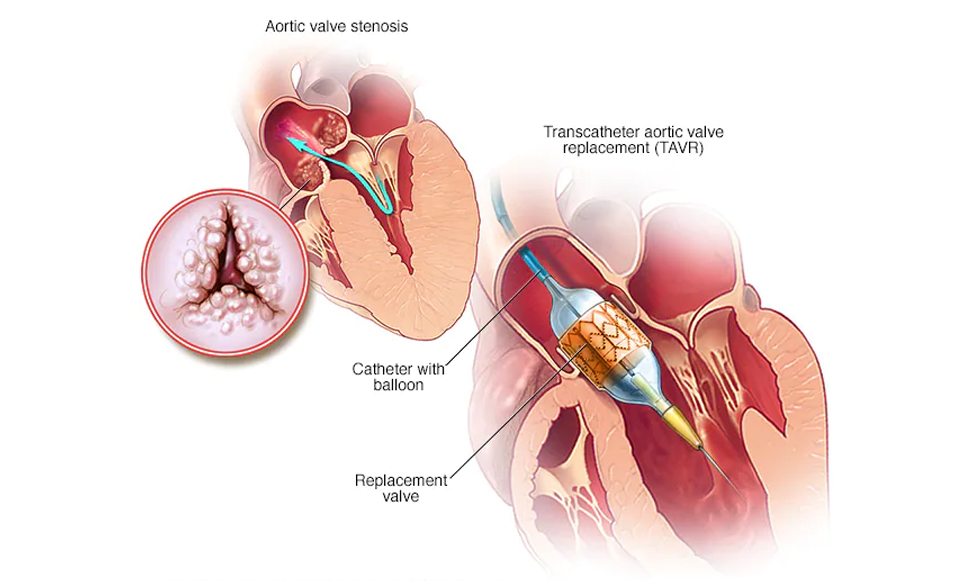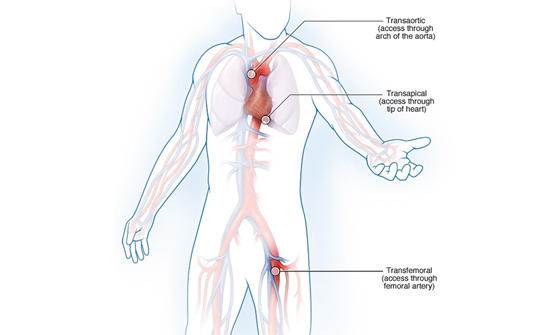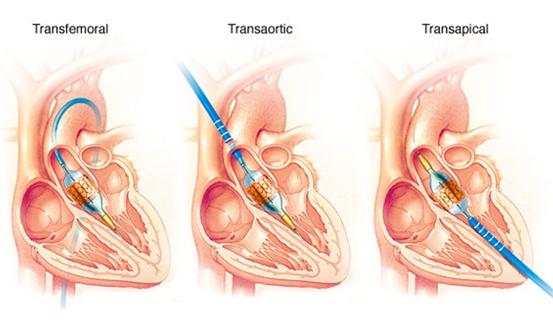Transcatheter aortic valve replacement (TAVR) is a minimally invasive heart procedure to replace a thickened aortic valve that can't fully open (aortic valve stenosis). The aortic valve is located between the left lower heart chamber (left ventricle) and the body's main artery (aorta). If the valve doesn't open correctly, blood flow from the heart to the body is reduced.
TAVR can help restore blood flow and reduce the signs and symptoms of aortic valve stenosis — such as chest pain, shortness of breath, fainting and fatigue.
TAVR may be an option for people who are at risk of complications from surgical aortic valve replacement (open-heart surgery). The decision to treat aortic stenosis with TAVR is made after a discussion with a team of heart and heart surgery specialists, who work together to determine the best treatment option for you.
Transcatheter aortic valve replacement may also be called transcatheter aortic valve implantation (TAVI).

In SAVR, the chest is opened and the Aortic Valve is replaced. The recovery time is more in SAVR. Where in TAVR/TAVI, it is done from a similar but a bit bigger incision from the groins under local anaesthesia and valve is implanted through a catheter in the heart, just like the umbrella opens.
Both TAVR/SAVR has their own limitations according to the patients profile and patients would be given options for either or both according to their profile.
TAVR valve is being expensive, at present the cost of the valve ranges from 13 lacs to 20 lacs, depending on the make and the country of origin.
Transcatheter aortic valve replacement (TAVR) is a treatment for aortic valve stenosis. Aortic valve stenosis — or aortic stenosis — occurs when the heart's aortic valve thickens and becomes stiff (calcifies). As a result, the valve can't fully open and blood flow to the body is reduced.
TAVR is an alternative to open-heart aortic valve replacement surgery. People who have TAVR often have a shorter hospital stay than those who have surgical aortic valve replacement.
Your doctor may recommend TAVR if you have:
Before a scheduled angioplasty, your doctor will review your medical history and do a physical exam. You may need to have some tests, including a chest X-ray, electrocardiogram and blood tests, before your procedure. Your doctor will also perform an imaging test called a coronary angiogram to see if the arteries to your heart are blocked and if they can be treated with angioplasty.
If your doctor finds a blockage during your coronary angiogram, he or she may decide to perform angioplasty and stenting immediately after the angiogram while your heart is still catheterized.
Your doctor will give you instructions to help you prepare.

Possible catheter access sites in transcatheter aortic valve replacement (TAVR) Open pop-up dialog box

Transcatheter aortic valve replacement (TAVR) procedure.
Transcatheter aortic valve replacement (TAVR) involves replacing a damaged aortic valve with one made from cow or pig heart tissue (biological tissue valve). Sometimes, the biological tissue valve is placed into an existing biological tissue valve that is no longer working.
Unlike surgical aortic valve replacement, which requires a long incision down the chest (open-heart surgery), TAVR is done using smaller incisions and a thin, flexible tube (catheter) to reach the heart.
To perform TAVR, a doctor inserts a catheter into a blood vessel, usually in the groin or chest area, and guides it into the heart. Moving X-ray images or echocardiogram pictures help the doctor place the catheter into the correct position.
A replacement valve made of cow or pig tissue is passed through the hollow catheter and placed in the area of the aortic valve. A balloon on the catheter tip inflates to press the new valve into place. Some valves expand without the use of a balloon.
The doctor removes the catheter once the new valve is securely in place.
During the TAVR procedure, the treatment team will carefully monitor your vital signs, including blood pressure, heart rate and rhythm, and breathing.
The procedure may take around two hours. The patient will be discharged in 2 or 3 days from the hospital, post procedure.